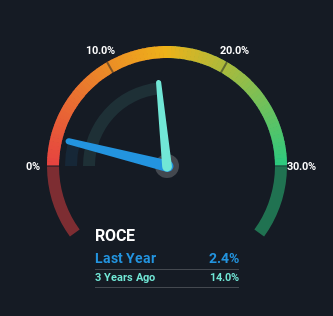- United States
- /
- Healthcare Services
- /
- NasdaqGS:PRVA
Some Investors May Be Worried About Privia Health Group's (NASDAQ:PRVA) Returns On Capital

To find a multi-bagger stock, what are the underlying trends we should look for in a business? Ideally, a business will show two trends; firstly a growing return on capital employed (ROCE) and secondly, an increasing amount of capital employed. This shows us that it's a compounding machine, able to continually reinvest its earnings back into the business and generate higher returns. However, after investigating Privia Health Group (NASDAQ:PRVA), we don't think it's current trends fit the mold of a multi-bagger.
Return On Capital Employed (ROCE): What Is It?
For those who don't know, ROCE is a measure of a company's yearly pre-tax profit (its return), relative to the capital employed in the business. Analysts use this formula to calculate it for Privia Health Group:
Return on Capital Employed = Earnings Before Interest and Tax (EBIT) ÷ (Total Assets - Current Liabilities)
0.024 = US$15m ÷ (US$1.0b - US$404m) (Based on the trailing twelve months to March 2024).
Therefore, Privia Health Group has an ROCE of 2.4%. In absolute terms, that's a low return and it also under-performs the Healthcare industry average of 11%.
Check out our latest analysis for Privia Health Group

Above you can see how the current ROCE for Privia Health Group compares to its prior returns on capital, but there's only so much you can tell from the past. If you're interested, you can view the analysts predictions in our free analyst report for Privia Health Group .
How Are Returns Trending?
We weren't thrilled with the trend because Privia Health Group's ROCE has reduced by 37% over the last five years, while the business employed 319% more capital. That being said, Privia Health Group raised some capital prior to their latest results being released, so that could partly explain the increase in capital employed. It's unlikely that all of the funds raised have been put to work yet, so as a consequence Privia Health Group might not have received a full period of earnings contribution from it.
In Conclusion...
In summary, despite lower returns in the short term, we're encouraged to see that Privia Health Group is reinvesting for growth and has higher sales as a result. However, despite the promising trends, the stock has fallen 57% over the last three years, so there might be an opportunity here for astute investors. As a result, we'd recommend researching this stock further to uncover what other fundamentals of the business can show us.
If you'd like to know about the risks facing Privia Health Group, we've discovered 1 warning sign that you should be aware of.
While Privia Health Group may not currently earn the highest returns, we've compiled a list of companies that currently earn more than 25% return on equity. Check out this free list here.
New: Manage All Your Stock Portfolios in One Place
We've created the ultimate portfolio companion for stock investors, and it's free.
• Connect an unlimited number of Portfolios and see your total in one currency
• Be alerted to new Warning Signs or Risks via email or mobile
• Track the Fair Value of your stocks
Have feedback on this article? Concerned about the content? Get in touch with us directly. Alternatively, email editorial-team (at) simplywallst.com.
This article by Simply Wall St is general in nature. We provide commentary based on historical data and analyst forecasts only using an unbiased methodology and our articles are not intended to be financial advice. It does not constitute a recommendation to buy or sell any stock, and does not take account of your objectives, or your financial situation. We aim to bring you long-term focused analysis driven by fundamental data. Note that our analysis may not factor in the latest price-sensitive company announcements or qualitative material. Simply Wall St has no position in any stocks mentioned.
Have feedback on this article? Concerned about the content? Get in touch with us directly. Alternatively, email editorial-team@simplywallst.com
About NasdaqGS:PRVA
Privia Health Group
Operates as a national physician-enablement company in the United States.
Flawless balance sheet and good value.


